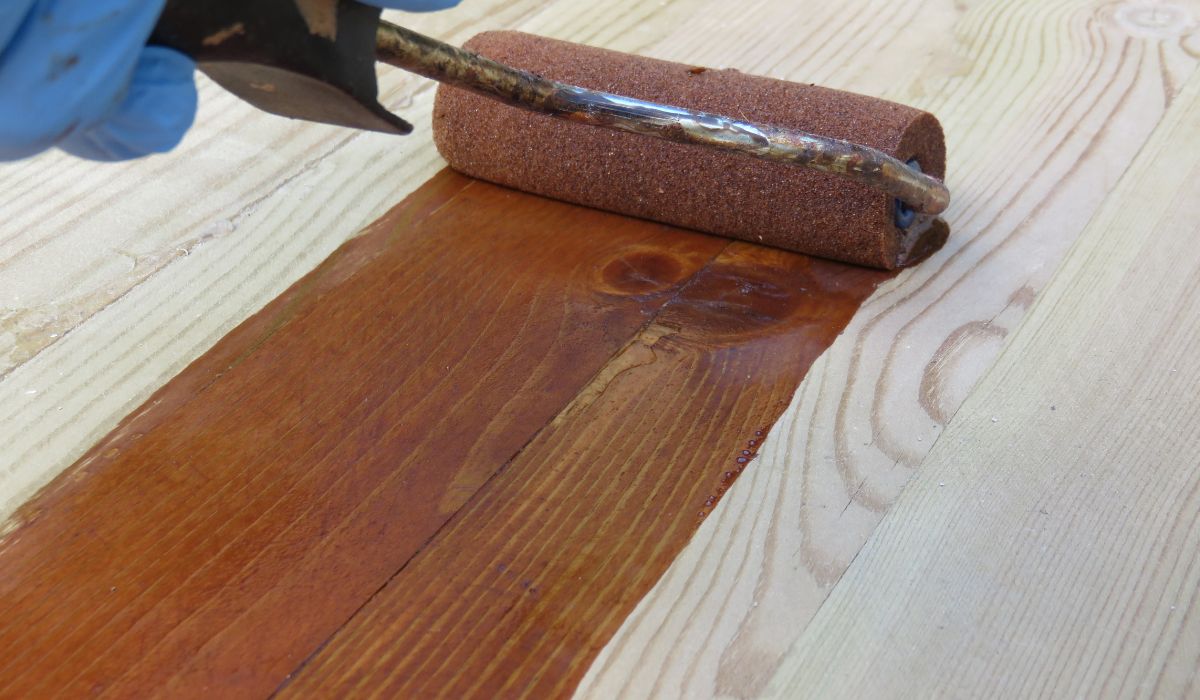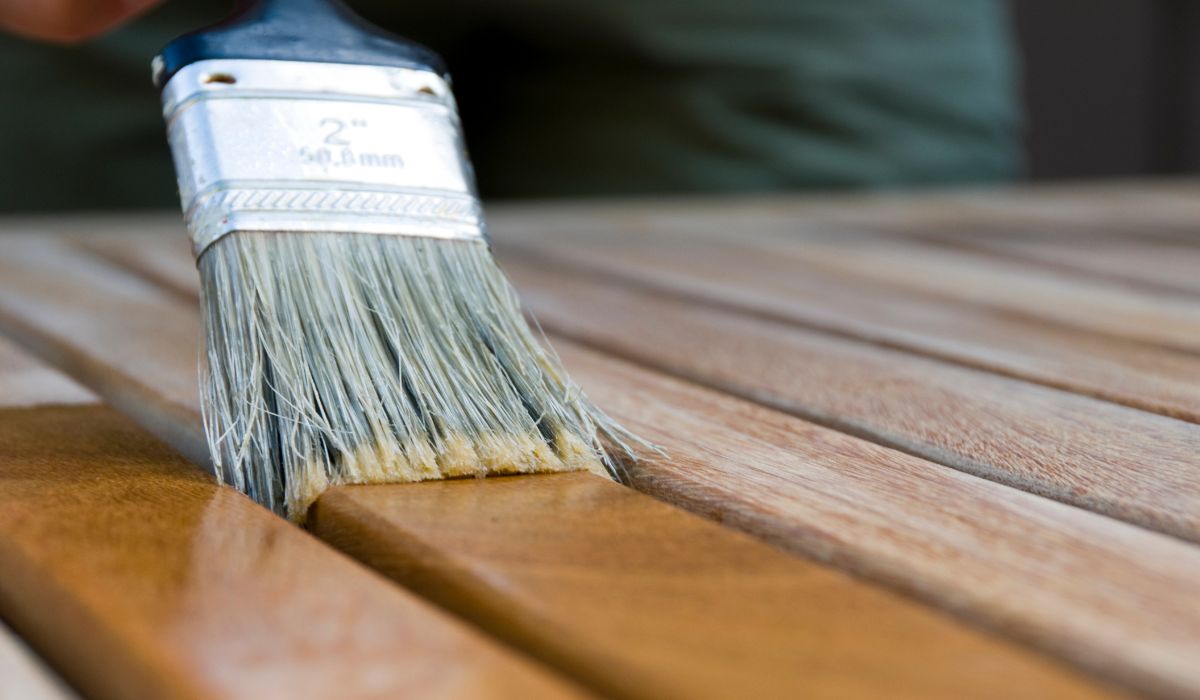Staining wood is a crucial part of any woodworking process. It seals the wood with a thin layer, preventing water from settling into the material’s pores. Without the staining process, your wood projects will become rotten as water seeps into the framework.

There are usually two types of stains you can choose from – oil-based and water-based. However, depending on the project you are working on, and depending on your overall design, picking the wrong stain could leave you with a disappointing finish. To avoid re-doing your project and starting from scratch, follow our guide to wood stains.
Oil-Based Wood Stains – What You Need To Know?
What Is Oil-Based Stain?
Oil-based stains are considered the most traditional of the two. They are made out of linseed oil, varnish, and petroleum distillates. Linseed oil is also known as flaxseed or simply flax oil. It is made from the flax plant (Linum usitatissimum), by drying out the ripened seed and pressing it to squeeze out the oil.
Although this oil is edible, you are more likely to find the liquid in crafting equipment such as paint binders, putty, and wood stains. This is because the dried version of the oil is great at repelling water and keeping materials ridged without leaving them brittle.
However, petroleum distillates are a hazardous material that can burn the skin, irritate the nose and negatively affect the nervous system causing a loss of balance, nausea, and headaches. As the name suggests, petroleum is liquid gasoline.
When using oil-based stains, most manufacturers recommend using a P-Series mask to prevent inhaling the toxic fumes. You can buy these in most DIY stores.
What Is It Good For?
Oil-based stains are particularly great at keeping the wood’s natural grain intact and visible while protecting the materials. This is the main reason why people use oil-based stains, but below are a few more aspects to consider.
Appearance
The natural grain of the wood will stay visible when using an oil-based stain. Depending on the color of the stain chosen, you will either end up with a darker version or a muted version of the natural textures. However, the knots and lines will remain as they are. If the oil is applied correctly, the wood will have a slight shine.
Lifecycle
Depending on where the wood resides, the oil will last between 2 to 4 years before it needs replacing. This is a long lifecycle, which means you don’t have to worry about maintenance. Keep this in mind when you want to stain wood that is in difficult or hard to reach locations.
What Is It Bad At?
People often avoid oil-based stains due to the harsh chemicals in the liquid. The chemicals are needed to slowly harden the wood, creating that waterproof barrier and the tightness needed for many projects.
Application
Applying oil-based wood stains can be difficult. You need to have additional equipment such as P-Series masks, otherwise, you may inhale too many toxins in the fumes. If too much is inhaled, you can experience vomiting and dizziness. To avoid this, most people apply the coat outside. This makes the odor and the fumes less pungent.
You also need to use a natural bristle brush. Pad applicators and synthetic filament brushes will work too, however old and ridged brushes can harm the wood or leave gaps in the application.
We do not recommend using a sprayer unless you are experienced. This is because the oil can easily pool if not applied properly, and sprayers do not have the precision needed for clean coverage.
Drying Time
If the conditions on the day of application are dry and warm, the drying time will be around 4 or 5 hours. However, because the stain will have a tacky texture long after drying, we recommend waiting a day before touching the stained wood again.
Cleaning Up
If you make a mistake with the oil, it can be difficult to clean up the area. Water will not rub the stain out because of the natural ability to repeal liquid. Instead, you will need mineral spirits to break down the oils, and a cloth to rub away the excess.
If you apply too much oil, it will pool on the surface of the wood. This will leave an unbalanced finish. To remedy the situation, use a cloth to remove any lumps.
Best Projects For Oil-Based Stains
Because oil-based stains are long-lasting and water-resistant, they work well on outdoor wood and wood that receives a lot of wear and tear.
Decking
Oil-based stains are the perfect choice for decking. You won’t need to reapply the oil every year, instead, you can wait for 2 years before reapplication, or (if the decking isn’t used often) you can stretch that touch-up for until 4 years have passed.
Deckings are outside, so we will benefit from water resistance. While the visible grains of the wood will give the flooring beautiful and natural textures.
Sheds
Sheds will also benefit from oil-based stains as the weather will take longer to beat off the protection. Although the shed floor might need a top-up every 2 years or so, the walls should be free from reapplication for 4 years.
Fencing
Continuing the outdoor theme, fences will also benefit from oil-based stains. Water is a great problem for wooden fences as the rain runs down the sides of the barrier. Oil-based stains are water resistant and so a gray winter’s day will not harm your fences.
Old Furniture
Lasting, going in a different direction, old furniture will be safely protected using oil-based stains. These stains can bring back life in the grain, emphasizing what is already there. It will also give a layer of protection to help the antique live for another couple of decades.
Because oil-based stains make wood rigid, this can help re-strengthen the desk/table/chair adding more stability to the furniture.
Water-Based Wood Stains – What You Need To Know?

What Is Water-Based Stain?
Water-based stains use water as a solvent, a binding ingredient that differs depending on the brand, and a dye to create the colors. Solvents are a liquid or material which allows other substances to dissolve. This means that water is used to dissolve the binding ingredient and the dye together.
Creating the solvent solution requires more technology than the oil counterpart. This is why water-based stains are often more expensive than oil-based stains. Don’t let the price tag put you off though, as this stain is easier to apply and doesn’t require safety gear.
What Is It Good For?
Water-based stains are often used to create vibrant blocky colors or because they are easy to apply. If you’re a beginner, a water-based stain is a great choice to help you learn the application method. And if you like bright colors or are happy to avoid natural-looking furniture, then the texture of the stain will be perfect for you too.
Appearance
After applying the correct number of layers to your wooden project, you can expect the appearance to look like a solid color. This is perfect for people with grand designs and those who want a less natural look.
Application
Applying water-based stains is easy. The more coats you add on, the stronger and more blocky the colors will be. If you’re worried about blotchiness, simply add another layer. Water-based stains will give you a smooth appearance without spending ages getting the quantity correct.
You can use cheap nylon or polyester brushes, or even rollers and sprays. Rollers and sprays are the best choices for large projects as you can cover more surface area in a short amount of time. Because you don’t need to be delicate with water-based stains, it doesn’t matter how often the same area gets sprayed.
Drying Time
Water-based stains are quick dryers. They only need 2 hours or less to dry completely, depending on how many layers you have applied.
Cleaning Up
If you make a mistake while painting you can easily wipe away the stain by using water and a cloth. You don’t have to buy a special solution to remove the stain. The same can be said when you clean the brushes too. Simply use hot water and dish soap to clean the rollers or brush thoroughly.
What Is It Bad At?
With all of these positive aspects of water-based stains, why would anyone pick oil? Unfortunately, it all comes down to durability.
Lifecycle
Water-based stains will only last for a year. Some latex-based stains can push for a longer period of 2 years, but that is only true if they are not used often. Many people will not apply water-based stains on commonly used flooring, such as decks, as this reduces the durability even further.
Not Water Resistant
Water-based stains also have a lower threshold for rainy weather. After it has dried, the water-based solvent in the stain can be reactivated when plunged into a body of water. If your fence is painted with this stain and a heavy rain cloud opens up over your home, you cannot expect the stain to protect the wood against rot.
Best Projects For Water-Based Stains
As you may have guessed from the lack of water resistance, water-based stains are best used in interior designs.
Children’s Furniture
Our first suggestion is children’s furniture. Because water-based stains create loud blocky colors, you can create classic designs that easily fit into children’s rooms. Although you’d have to repaint the wood every year or so, this would tie in well with a child’s disposition.
Children change their styles at a rapid pace, so if they decide that pink is no longer for them, it won’t feel like a waste when you sand down the wardrobe to re-stain the wood.
Upcycling
Upcycling is when you buy an old piece of furniture or find something similar in your home already, and make it look new again. Upcycling has become a fashionable way to change your style or interior design without throwing away your current furniture.
To upcycle something you simply need to repaint it, replace the materials with new fabric, or fix any broken pieces. As your style changes, you can keep sanding down the wood and re-staining it to match your new style. It’s a money saver and a fun crafting activity.
Interior Furniture
Lastly, we recommend using water-based stains on any of your interior furniture. Although the stain isn’t as durable as oil-based versions, the furniture won’t have to contend with natural forces such as the weather or sunlight. Instead, you only have to consider how often the item is used, and where the item is used.
For example, a bookshelf’s frame will not be worn down quickly, by the shelves themselves could be in constant use. However, these shelves will normally be covered in books, so no one will see the wear and tear. Understanding this can help you realize where water-based stains will be easy to maintain.
Summary
Water-based stains and oil-based stains each have their pros and cons. If you are an experienced DIYer and have the right equipment at home, then using oil-based stains is your best choice. If you’re inexperienced and want to try upcycling your old furniture, you should pick water-based stains.
